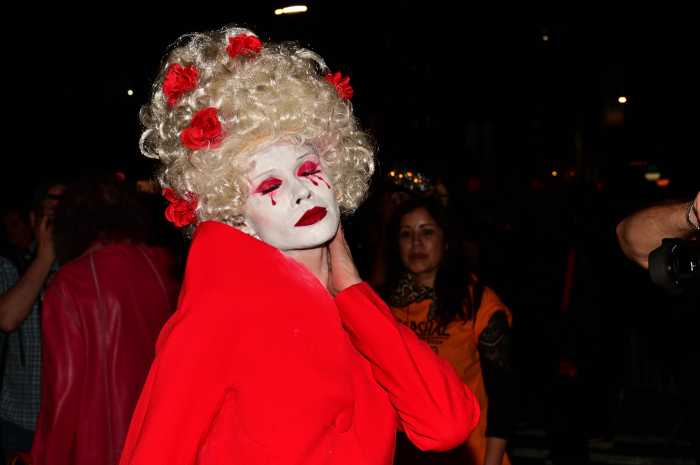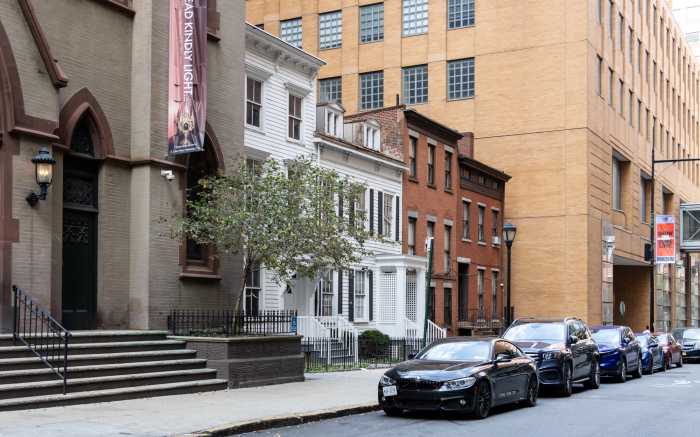From a distance, the Chelsea Espresso Bar at the corner of Seventh Ave. and 22nd St. looks promising.
Move closer, however, and the defunct café’s entrance appears graffiti-strewn and covered in contact paper. The locked front door stands beneath a fading awning with missing strips of fabric and discolored by a stream of pigeon droppings. Peeping into a small hole on one side reveals a musty interior stacked with boxes and garbage. The only sign of life is a huge Levi’s ad plastered to the Seventh Ave. side of the building, with an aging “For Rent” placard posted above.
On the corner of this residential street, the building has become the bane of neighbors’ existence. With no one around to maintain the six-story structure, trash accumulates daily. There’s also an alleged vermin problem, and various homeless individuals congregate out front each day, drinking, panhandling, sleeping and urinating in nearby bushes, according to neighbors.
“It’s all locked up,” said a grizzled man named Steve, one of the much-maligned roustabouts, sitting on the stoop of the empty storefront eating a sandwich. He’s lived in the area for 15 years and used to have a place down the street.
Ellen Levin has owned the adjacent building on W. 22nd St. since 1995. She attributed the property’s unsightly conditions to the neglect of landlord Errol Rainess, the listed owner, who she claimed spends most of his time in Belgium. As for the coffee shop, Levin said it’s been closed since 2002 after Rainess doubled the rent.
The landlord also seems to have a combative style of dealing with local residents. Levin said that he once told a complaining neighbor that he was going to put a dead bird in her planter. Soon after, a deceased sparrow appeared in that very spot.
Levin and other neighbors have called 311 repeatedly and lodged complaints with the Department of Buildings. Still, she said, nothing’s changed. There’s nobody to take care of the sidewalk, even when it snows.
Rainess’s lax approach to building management also extends to the coast of New Brunswick in Canada, where he owns a crumbling lighthouse called Grand Harbour Light. With its collapse imminent, the structure has drawn attention from the American Lighthouse Foundation and has been deemed the “most endangered in North America” by Lighthouse Digest.
The DOB’s records show a litany of complaints against the Seventh Ave. property, with at least 31 filed since 1997. In response to a recent complaint, a violation was issued on July 26 for the owner’s “failure to maintain building wall,” according to the department’s Web site. A spokesperson for the DOB explained that the agency did issue a violation—which can be seen taped to the property’s front door— for failure to maintain the wall, and that the owner needs to repair the building to ensure structural stability. Rainess could not be reached for comment through a pair of phone listings in his name at the Seventh Ave. property.
Deborah Fenker, who’s lived on W. 22nd near the building for about eight years, said that initially Rainess “seemed like he was going to put something in” the vacant retail space. “They had the space gutted for a wine bar on the first floor and a speakeasy in the basement,” she explained.
However, Fenker claimed that Rainess was so difficult to deal with that the tenants who had planned to rent from him abandoned their project. A similar scenario occurred with another prospective tenant, she added.
Fenker also confirmed that the landlord lives in Belgium most of the year, usually staying in New York during the summer. “The last time I saw him was once last summer in the neighborhood—not in front of his building, though—and I haven’t seen it at all since then.”
The building does appear to draw revenue from the advertisements stretching across the ground-floor windows on the Seventh Ave. side that change every few weeks. “He told me that he got good money for having those ads up in the windows,” Fenker added.
“It’s remarkable to see a building in that location that’s been abandoned, except for the constant stream of advertising,” said Andrew Berman, the executive director of the Greenwich Village Society for Historic Preservation and a public member of Community Board 4.
But even the ads, the only bright spot on the otherwise derelict property, may be illegal. Berman explained that there are two types of signage allowed on New York City buildings—on-premise business signs and those allowed on commercial strips in residential neighborhoods.
“If you’re just renting out space on your building that has nothing to do with your business or business nearby… ad signage is not allowed,” he said. “The irony is that landlord is probably getting income from this probably illegal ad when some much more legitimate use would also guarantee income and be much more compatible with neighborhood.”
In January, a complaint was made with the DOB about the illegal advertisements. A department spokesperson said that whatever the specific case with the building may be, advertisements on buildings are restricted to certain areas and zones, and must be installed with a required permit.
Another property owner on the same block contended that it “could be a beautiful building if it was restored or fixed up.” The man, who wished to remain anonymous, has gone to several police precinct council meetings to discuss the panhandling.
“It’s dangerous because they’re in the middle of the street,” he said of the homeless congregants. “But the police said they can’t get them for that. … It’s an issue that’s really affected this block for a couple years now, and it feels like there’s nothing much we can do, unfortunately.”
Ed Tristam, the superintendent of another building on W. 22nd St. who has lived there for nine years, worries that it “might be a route for burglars to make it into backyards or to get into other buildings.” As for the homeless gathering daily, “they never did that when [the space] had a commercial use,” Tristam noted.
For now, the drama surrounding the empty structure continues. According to Levin, just the other day a homeless man fell outside the building, bloodying his face. She called an ambulance, but the injured man didn’t want to be taken to the hospital.
“It’s just not a very good situation,” she said “There’s something else almost every day.”



































